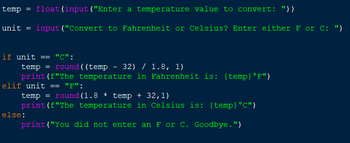
I should have included the code that I already have. I've attatched an image of what I've already done. Is it possible for you to fit in the case insensitive coding to what I've already got? I'm very confusd.

1- This is correct, Python is a case−sensitive programming language. It suggests that it feels uppercase and lowercase letters differently.
2- Case-insensitive means the string that the user is reaching should be the same as a string that is to be compared but both strings can be either in upper case or lower case.
3- But in this example, or condition is used to make the if, elif condition in an insensitive format.
4- If the user enters either f capital letter or a small letter it should work
5- In the same way for C also.
Example -
if unit == "C" or unit == "c":
elif unit == "F" or unit == "f":
1- upper() & lower() methods used to ignore case in python.
2- The upper() method is used to convert all the lower letters to upper case format.
3- lower() method is used to convert all the upper letters to lowercase format.
Step by stepSolved in 3 steps with 2 images

- It is advisable for professionals in the field of information technology to acquaint themselves with the policies and guidelines established by the government of the People's Republic of China. Is the possession of this item by programmers truly a matter of concern? To what degree and within which context, precisely?arrow_forwardCan programming flaws be fixed with smarter code? Is there a good or bad connotation to this?arrow_forwardAn ancient programming adage advises against coding. That means what?arrow_forward
- State a problem that can occur with input validation when the Unicode character set is used.arrow_forwardThe ROT-13 algorithm encrypts a string one character at a time by adding 13 to the value of the internal representation of the character. We want our encryption scheme to cover the entire printable ASCII range. After examining the ASCII character set and their internal representations, we see that characters 0 through 32 and character 127 are control characters. Technically, characters 32 (space) and 127 (DEL) are printable, but we don’t want to include them in our encryption routine. Therefore, we want our encrypted string to only contain characters in the range of 33 through 126. As an example: Plaintext: Norwich Ciphertext: [|!&vpu The internal representation of ‘N’ is 78. 78 plus 13 is 91, which is the character ‘[‘. The internal representation of ‘o’ is 111. 111 plus 13 is 124, which is the character ‘|’. The internal representation of ‘r’ is 114. 114 plus 13 is 127. Since 126 is our maximum value for our desired printable range, we…arrow_forwardNo plagarism please! Correct and detailed answer will be Upvoted else downvoted. Thank you!arrow_forward
 Database System ConceptsComputer ScienceISBN:9780078022159Author:Abraham Silberschatz Professor, Henry F. Korth, S. SudarshanPublisher:McGraw-Hill Education
Database System ConceptsComputer ScienceISBN:9780078022159Author:Abraham Silberschatz Professor, Henry F. Korth, S. SudarshanPublisher:McGraw-Hill Education Starting Out with Python (4th Edition)Computer ScienceISBN:9780134444321Author:Tony GaddisPublisher:PEARSON
Starting Out with Python (4th Edition)Computer ScienceISBN:9780134444321Author:Tony GaddisPublisher:PEARSON Digital Fundamentals (11th Edition)Computer ScienceISBN:9780132737968Author:Thomas L. FloydPublisher:PEARSON
Digital Fundamentals (11th Edition)Computer ScienceISBN:9780132737968Author:Thomas L. FloydPublisher:PEARSON C How to Program (8th Edition)Computer ScienceISBN:9780133976892Author:Paul J. Deitel, Harvey DeitelPublisher:PEARSON
C How to Program (8th Edition)Computer ScienceISBN:9780133976892Author:Paul J. Deitel, Harvey DeitelPublisher:PEARSON Database Systems: Design, Implementation, & Manag...Computer ScienceISBN:9781337627900Author:Carlos Coronel, Steven MorrisPublisher:Cengage Learning
Database Systems: Design, Implementation, & Manag...Computer ScienceISBN:9781337627900Author:Carlos Coronel, Steven MorrisPublisher:Cengage Learning Programmable Logic ControllersComputer ScienceISBN:9780073373843Author:Frank D. PetruzellaPublisher:McGraw-Hill Education
Programmable Logic ControllersComputer ScienceISBN:9780073373843Author:Frank D. PetruzellaPublisher:McGraw-Hill Education





